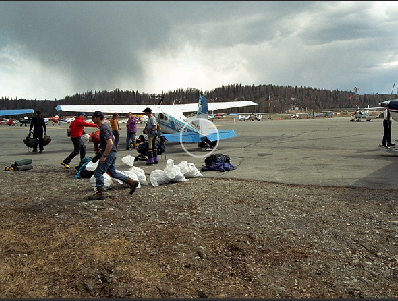Denali (20,320ft/6,195m) Alaska
- Talkeetna Airport, Talkeetna, AK, United States
- Active & Adventure

| from $6,400* per person | 21 Days | May, June |
| Comfort accommodations | Exertion level: 3 | |
| Operator: Alpine Ascents International | 6 people max | |
Denali is often considered America's most classic climb. From top to bottom, it rises nearly 18,000', an elevation gain unsurpassed anywhere in the world. At a northern latitude of 63°, it is the most northerly of any big mountain over 20,000'. No other region offers such breathtaking and diverse views each day of the ascent. The panorama from Denali's summit includes Mt. Foraker, Mt. Hunter and Mt. Huntington in all their majestic glory.
When Dr. Bradford Washburn pioneered the West Buttress route, he heralded in a new era of Denali ascents and offered climbers a unique approach to the summit. The flight onto the glacier is a trip in itself, presenting overwhelming vistas of the Alaska Range. The West Buttress route remains, by far, the most successfully climbed route on the mountain.
Loading map, please wait...
Locations visited/nearby
Alaska, United States
Itinerary
Day 1: 8:30am Meet in Talkeetna. Meet at the Alpine Ascents Office (Climbers arrive in Talkeetna one day prior. All transport information will be forwarded upon receipt of application.) After introductions, orientation and final gear check we board a ski-equipped aircraft and fly to Base Camp on the S.E. Fork of the Kahiltna Glacier (7,300’). The flight to Base Camp is marvelous, presenting outstanding views of a variety of peaks including Mt. Foraker, Mt. Hunter and Moose’s Tooth. Upon arrival we prepare our Base Camp. (Glacier Travel review may be done on this day.Day 2: Glacier Travel review.
Day 3: Carry loads to Camp I (7,900’). Snowshoes may be necessary between camps on the lower part of the mountain. Double carries are sometimes made between most camps to allow for proper acclimatization and lighter load carries. (Conditions may warrant us to single carry to Camp I).
Day 4: Move to Camp I. (This may be a single carry)
Day 5: Carry loads to Camp II (10,000’), at Kahiltna Pass. This route follows the Kahiltna glacier.
Day 6: Move to Camp II.
Day 7: Carry gear to Camp III (11,500’). We turn west and ascend steep terrain. Camp III offers exquisite views and vistas of the 3,000’ rock and ice face on the edge of the West Buttress.
Day 8: Move to Camp III.
Day 9: Carry gear to Camp IV( 14,200’). We will pass around Windy Corner, which exposes stunning panoramic views of surrounding peaks and the northeast fork of Kahiltna Glacier, 4,000’ below.
Day 10: Move to Camp IV. Depending upon climbing conditions, we may spend an extra day moving gear to Camp IV. This will aid acclimatization and break up the long carry.
Day 11: Rest and acclimatize Camp IV. The upcoming ascent is the most demanding part of the climb.
Day 12: Carry loads to 16,800’. From Camp IV we ascend 1,100’ of moderate snow slopes to reach the beginning of the fixed lines. Using ascenders on the lines to self-belay, we ascend the Headwall, which consists of 900’ of 45°- 50° snow and ice. Upon reaching the crest of the West Buttress, we enter the world of the mountaintops. The climb takes on an entirely different nature as the feeling of being amongst the clouds and peaks permeates the senses.
Day 13: Rest Day at Camp IV.
Day 14: Carry and move to Camp V (17,200’). We follow an exposed ridge around Washburn’s Tower, which merges into the main massif of Denali. Camp V is established on a saddle just above Rescue Gully and overlooks 3,000’ to Camp IV.
Day 15: Rest day. Rest and prepare for the summit attempt.
Day 16: Summit day. We traverse across a steep snow face to Denali pass. From here we follow gentle slopes to reach Archdeacons Tower and a large plateau at 19,400’, known as the “football field.” From the plateau we ascend on moderate terrain to the crest of the summit ridge. From this vantage point, we look upon the immense 8,000’ South Face, with Cassin Ridge and the South Buttress in full view. As we follow an exposed ridge up the last 300’, excitement grows as we approach the top of North America.
From the summit we have a 360° view of the Alaska Range, with Mt. Hunter and Mt. Huntington to the south and Mt. Foraker to the west. These peaks, along with scores of others, mark this mountain view as one of the most impressive in the world. At the end of the day we return from the summit to spend the night at high camp.
Days 17 – 18: Return to Base Camp. From high camp we spend two days returning to Base Camp where we will board our plane and return to Talkeetna and then on to Anchorage.
Days 19 – 21: Extra Days. Extra days for inclement weather and acclimatization may be utilized at any point on the expedition.
Day 21: Return to Talkeetna.
More information from Alpine Ascents International:
- View trip on provider's website
www.alpineascents.com/denali.asp… - Company profile, experience, and history
- View all of their trips
- Email this trip page to a friend
-



Comments from Facebook